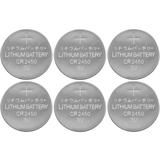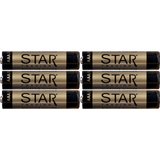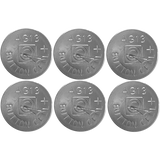STAR TRADING Batteries (not reachargeable)








star trading batteries non rechargeable portfolio and where they make sense
This range is for the everyday loads that don’t need charging infrastructure: wall thermostats, PIR sensors, hotel remotes, point-of-sale peripherals, beacons, fairy-light controllers, and maintenance stock for seasonal décor. Form factors follow IEC sizing so swap-outs are painless on site: AA (LR6), AAA (LR03), C (LR14), D (LR20), 9 V (6LR61), plus the coin/button family (CR2032/2025/2450) and photo cells (CR123A, CR2, 2CR5, CR-P2). Mercury- and cadmium-free chemistry is the default; all packs carry clear date and lot codes for fleet rotation.
star trading disposable batteries chemistries and formats
You’ll see three practical chemistries:
- Alkaline (1.5 V) for controls, toys, and general electronics—best day-to-day value per hour.
- Lithium-metal (3 V coins; 3 V/6 V photo) for compact gear and cold environments; long shelf life.
- Zinc-carbon (1.5 V) for very light loads and budget lines—fine in clocks and simple remotes.
Packaging comes as retail blisters for room stock, contractor sleeves (e.g., 10× AA/AAA), and cartonized outers for stores. Mixed inner packs (AA/AAA + 9 V) simplify service trolleys in hotels and offices.
star trading alkaline batteries performance data installers rely on
- Nominal 1.5 V; open-circuit ~1.60 V new.
- Typical capacity (20–25 °C, light–medium drain): AA 2 700–3 000 mAh; AAA 1 000–1 200 mAh; C 6 000–8 000 mAh; D 12 000–15 000 mAh; 9 V 500–600 mAh (at 10 mA to 6.0 V).
- Shelf life ~5 years sealed at 20 °C; self-discharge low enough for annual stock cycles.
- Operating window −20…+54 °C (best results 0…+35 °C).
- Leak-resistance: gas-management seals and inhibitor additives; still, remove cells from seasonal gear during storage.
For LED chains and sensor loads, size by minimum voltage under load—not just by milliamp-hours—so dimming curves don’t collapse early.
star trading primary batteries for long duty and low temperatures
Lithium-metal cells take over where runtime and cold start matter.
- Coins (CR2032/2025/2450): 3 V, 200–240 mAh for 2032; shelf life 7–10 years; −30…+60 °C typical.
- Photo cells (CR123A/CR2/CR-P2/2CR5): high pulse capability for motion sensors and camera gear; shelf life up to 10 years.
Use child-resistant coin packaging on projects with public access; specify warning inserts for facilities teams—coin ingestion policies are no longer optional.
Range structure and quick picks
- Controls & thermostats: AA/AAA alkaline; choose higher-grade lots where polling current spikes.
- Security PIRs & beacons: CR123A or lithium AA if the head accepts it; cold foyers behave better on lithium.
- Clocks, simple remotes: zinc-carbon AA/AAA—lowest cost, low drain.
- Festive micro-packs: coin cells (CR2032) or AA alkaline depending on the controller; keep spare trays near decorations storage.
If a tender says star trading standard batteries, assume alkaline unless the device spec calls out lithium or zinc-carbon explicitly.
Electrical, safety, and compliance notes
- Conforms to IEC 60086 (primary battery safety/performance).
- RoHS/REACH compliant; no added Hg/Cd.
- Coin cells ship with child-safety messaging; request tamper-evident blisters for public spaces.
- Transport: lithium-metal falls under UN 3090/3091—use the supplier’s packing instruction sheet when you plan bulk moves or air freight.
Storage target: 10–25 °C, 40–60 % RH, away from direct sun and heating plant; don’t mix new and used cells in the same device.
Procurement logic for multi-site clients
Group by chemistry + size + pack type, then note the annual room count. Example lines:
- “Alkaline AA LR6, contractor 10-pack, 1 000 packs/yr, housekeeping pull.”
- “CR2032 coin, child-safe blister, 500 blisters/yr, front-desk pull.”
- “CR123A photo, bulk 12-pack, 200 packs/yr, security team.”
Where bundles are requested as star trading battery packs, standardize two SKUs per site (AA/AAA alkaline) plus one lithium line for sensors; it keeps van stock lean and audits simple.
Instalation and maintenance tips from field teams
Label the feeder or drawer with the install date; swap sets by room, not cell-by-cell, to keep performance predictable. Remove cells from stored seasonal décor. For coin-cell holders in signage, confirm spring tension—loose contacts mimic flat batteries. Keep a small spill kit and nitrile gloves with the stock; alkaline leakage is rare but messy if ignored.
Typical questions from specifiers
Can we run LED strings on zinc-carbon? Yes for very light, short runs; for clusters or timers, alkaline lasts longer and holds voltage better.
Why do thermostats die early on alkaline? Pulse loads; lithium holds up better below 0 °C and during radio bursts.
Do we need 9 V spares? Keep a modest tray; smoke heads are increasingly lithium or hard-wired, but legacy stock remains.
Selection checklist for buyers
- Chemistry (alkaline vs lithium-metal vs zinc-carbon) by device and ambient.
- Size (LR6/LR03/6LR61/CR2032/CR123A etc.).
- Pack (blister vs contractor vs carton) and storage plan.
- Shelf life requirements for low-turnover sites.
- Safety (coin packaging, public-area policy).
- Logistics (UN handling for lithium-metal when shipping by air).
When a tender uses consumer language like star trading single use batteries, mirror the term on the sheet but keep chemistry and IEC size explicit.
Bankoflamps B2B handling
We map cell sizes and chemistries to device lists per site, then publish annual draw-down so purchasing isn’t guessing. The portal shows live EU stock; quotes typically land in about an hour with EAN/MPN, shelf-life, and packing notes. Orders go in by manufacturer code; dated price lists keep budgets stable. We track lead times and consolidate cartons by zone to cut freight and back-of-house handling. Approved accounts can use post-payment up to 30 days across France, the Baltics, Germany, Spain, Italy, Belgium, and the Netherlands.